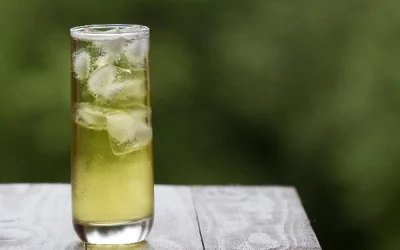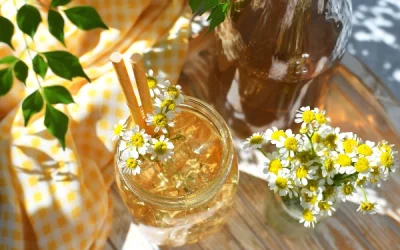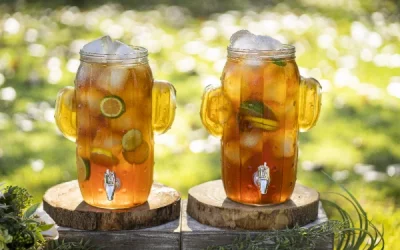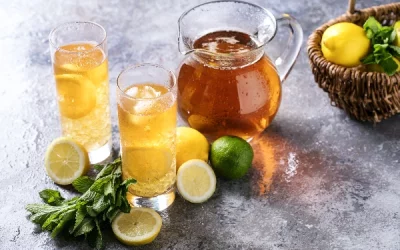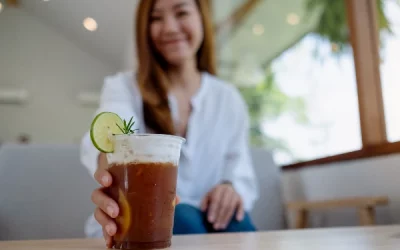Did you know that iced tea has been a beloved refreshment for centuries, tracing its roots back to ancient China? This cool beverage has since evolved into a global staple, cherished for its unique flavours and health benefits. In this article, we’ll explore everything you need to know about iced tea—from its fascinating history to preparation methods, popular flavours, and health advantages. Join us on this delightful journey to discover why iced tea deserves a place in your beverage repertoire!
Table of Content
What is Iced Tea?
Iced tea is a form of cold tea, often served with ice cubes. It can be sweetened or unsweetened and is sometimes flavored with lemon, peach, raspberry, or other fruit flavors. Here are some key points about iced tea:
- Preparation: Iced tea can be made by brewing tea leaves or tea bags in hot water, then cooling it down and serving over ice. Alternatively, cold brew methods can be used, where tea is steeped in cold water for several hours.
- Types of Tea: Various types of tea can be used to make iced tea, including black tea, green tea, white tea, and herbal teas.
- Sweetened vs. Unsweetened: Sweetened iced tea, particularly popular in the southern United States, often contains sugar or sweeteners added during the brewing process. Unsweetened iced tea contains no added sugars.
- Flavored Iced Tea: Common flavors include lemon, mint, peach, raspberry, and other fruits. These flavors can be added through syrups, slices of fruit, or infused during the brewing process.
- Commercially Available: Iced tea is widely available commercially in bottled or canned form, with a variety of flavors and sweetening levels.
- Health Aspects: Iced tea can be a refreshing and lower-calorie alternative to sugary sodas if consumed unsweetened or with minimal sweetening. The antioxidants in tea also offer some health benefits.
Iced tea is enjoyed worldwide, particularly in warm climates, as a refreshing beverage.
What is the history of ice tea?
Iced tea has a captivating history that spans across continents and centuries. Its story begins in China, where tea leaves were first cultivated and consumed as a hot beverage over 5,000 years ago. Tea became an integral part of Chinese culture, praised for its taste, aroma, and health benefits. The idea of chilling tea might have seemed almost sacrilegious to early tea connoisseurs but was an innovative twist that eventually captured global interest.
The introduction of iced tea to the United States marked a significant turning point. In the 19th century, the concept of serving tea cold started gaining attention, especially during warm summer months.
Among the key events that popularised iced tea was the 1904 World’s Fair in St. Louis, where Richard Blechynden, trying to promote hot tea, decided to serve it over ice to combat the sweltering heat. This clever adaptation struck a chord with fair-goers and helped launch iced tea into mainstream American culture.
How did ice tea originate?
Iced tea’s roots can be traced back to China, though it wasn’t initially consumed cold.
- China was the birthplace of tea, with ancient farmers cultivating tea leaves for medicinal use.
- By the Tang Dynasty (618-907 AD), tea became a widely enjoyed beverage in China.
- As tea culture spread across Asia and eventually Europe, different varieties and brewing methods emerged.
- The idea of chilling tea developed as a method to preserve brewed tea and make it more refreshing during hot weather.
- These early adaptations perhaps laid the groundwork for the iced tea we know today.
Iced tea’s journey from a traditional Chinese remedy to a popular refreshing drink highlights its adaptability and widespread appeal. The original Chinese tea leaves imbued these practice with time-honoured traditions and benefits, which carried across new interpretations through the centuries.
When did ice tea become popular in the United States?
The spotlight shone brightly on iced tea in 1904, during the St. Louis World’s Fair. Richard Blechynden, a tea plantation owner, faced disinterest in his hot tea samples during a hot summer day. A quick adjustment led him to pour tea over ice, instantly turning it into a delightful refreshment.
- Initially, his intention was to attract more visitors to his exhibit.
- The unexpected success resulted in widespread curiosity and interest.
- Newspaper articles from the time raved about the novelty of iced tea.
- American cookbooks began including recipes for iced tea by 1917.
- The prevalence of iced tea increased further due to Prohibition, where it served as an excellent non-alcoholic alternative.
Following the World’s Fair, iced tea gained a massive foothold in American households. Its appeal was boosted by changing social trends and preferences for lighter, refreshing drinks during the hotter months.
How has ice tea evolved over the years?
The evolution of iced tea saw creative spins on classic recipes and the introduction of diverse flavours.
- Sweet Tea became synonymous with Southern United States culture, often steeped with a generous amount of sugar.
- Varieties like Long Island Iced Tea emerged, which includes a mixture of spirits.
- Green and herbal iced teas gained popularity in recent decades, touted for their health benefits.
- Ready-to-drink and bottled iced teas became common in supermarkets.
- Fresh fruit infusions, herbs, and spices now add a rich spectrum of flavours to traditional iced tea.
The modern-day iced tea reflects global influences, diverse palates, and innovative culinary creativity. From traditional sweet teas to exotic blends, iced tea has transformed into a beverage that caters to numerous tastes and preferences.
In ancient China, tea was considered a medicine. Shennong, a legendary emperor and herbalist around 2737 BC, discovered tea when leaves from a wild tree blew into his pot of boiling water. Intrigued by the aroma, he tasted the infusion and found it refreshing. This discovery marked the beginning of tea’s illustrious history. Shen Nong’s legendary finding highlights how chance occurrences can change cultural practices and lead to new traditions.
Speaking from experience, there’s something special about preparing iced tea at home. I remember one summer, experimenting with different herbs and fruits in my iced tea recipe. The combinations of mint leaves and fresh lemon slices created a refreshing burst of flavour—perfect for hot afternoons.
It’s amazing how a simple drink can bring such joy and refreshment, reminding you of both tradition and innovation.
How is iced tea prepared?
Preparing iced tea can be an enjoyable experience, offering you various methods to suit your preferences. You can make iced tea by hot brewing, cold brewing, or even using instant tea powders. Each method has its own unique process and flavour outcomes.
Here is a table that outlines different methods for preparing iced tea. It includes the required ingredients, steeping time, and appropriate temperature:
| Method | Ingredients | Steeping Time | Temperature |
|---|---|---|---|
| Hot Brew | Tea leaves, water | 5-7 minutes | Boiling |
| Cold Brew | Tea leaves, water | 8-12 hours | Room temperature |
| Sun Tea | Tea bags, water | 3-5 hours | Sunlight |
| Instant Tea | Instant tea powder, water | Instant | Cold |
| Flash Chilled | Tea leaves, water, ice | 5 minutes | Boiling, then iced |
| Kyoto Style Brew | Tea leaves, ice cubes | 6-8 hours | Melting ice |
| Sparkling Iced Tea | Tea leaves, water, sparkling water | 8-12 hours (cold brew) | Cold |
To use this table, simply pick a method that suits your convenience or taste preference. Make sure you have the correct ingredients and follow the steeping times and temperatures for the perfect iced tea.
What are the common methods of making iced tea?
There are several ways to serve up a refreshing glass of iced tea. Different methods can yield distinct flavours and suit various levels of patience and kitchen prowess.
- Hot Brew: This classic approach involves steeping tea leaves in boiling water and then chilling the tea with ice or in the fridge.
- Cold Brew: This method brews the tea slowly over several hours using cold or room temperature water. It’s often smoother in flavour.
- Sun Tea: Sun tea uses the heat of the sun to warm the water and infuse the tea, making the process both intriguing and eco-friendly.
- Instant Tea: Perfect for those in a hurry. Instant tea powders dissolve quickly in cold water.
- Flash Chilled: Steep tea leaves in boiling water, then rapidly chill it with ice for a quick turnaround.
- Kyoto Style Brew: Known for its concentrated flavours, this unique method uses ice cubes to melt gradually over tea leaves.
- Sparkling Iced Tea: Add some fizz to your regular iced tea by using sparkling water. Usually this involves cold brewing and then mixing with sparkling water.
While hot brewing gives a robust flavour, cold brewing often produces a lighter and smoother iced tea. Sun tea has its own charm, harnessing natural sunlight to brew the tea. Instant tea is quick but may lack the depth found in traditional methods.
How does the hot brew method work?
The hot brew method is quick and straightforward, making it a popular choice for many. You start by boiling water and steeping your tea leaves or bags in the hot water.
Hot Brew Method:
- Boil water and pour it over tea leaves or tea bags.
- Allow the tea to steep for 5-7 minutes.
- Remove the tea leaves or bags and let it cool.
- Add sweeteners if desired.
- Chill in the fridge or pour over ice.
Steps to follow:
- Boil water and pour it over your tea leaves or tea bags.
- Steep for 5-7 minutes to allow the flavours to develop.
- Remove the tea and let it cool down.
- Sweeten as per taste, then chill it in the fridge or immediately serve over ice.
Hot brewing is flexible and allows you to experiment with different tea types and flavour add-ins such as mint, lemon, or honey. This method is best for those who need iced tea quickly and appreciate a strong flavour.
What makes cold brew iced tea unique?
Cold brew iced tea is distinctive due to its longer brewing time and the mild, less bitter flavour it produces. It’s simple to create but does require some patience.
Cold Brew Method:
- Combine tea leaves with cold or room temperature water.
- Let it sit for 8-12 hours, preferably overnight.
- Strain the leaves from the liquid.
- Serve chilled, with or without sweeteners.
Steps to follow:
- Place tea leaves in a pitcher of cold or room temperature water.
- Let it steep for 8-12 hours, typically overnight.
- Strain out the tea leaves.
- Pour over ice and serve. Add sweeteners if desired.
Unlike hot brewing, cold brewing minimises the release of tannins, resulting in a smoother, less astringent tea. This method is perfect for those who prefer a more nuanced flavour profile and don’t mind waiting.
In the 1904 St. Louis World’s Fair, Englishman Richard Blechynden was attempting to market Indian tea. However, the sweltering summer weather made hot tea unappealing. Ingeniously, he poured his brewed hot tea over ice, giving birth to iced tea as we know it today. This refreshing beverage became an instant sensation, solidifying its spot as a favourite summertime drink.
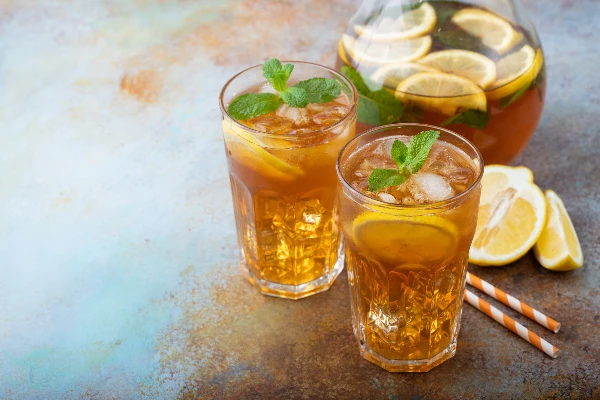
What are the different flavours of iced tea?
When it comes to iced tea, there’s a snowball’s chance in summer heat that you’d run out of options. This versatile drink can be as unique and varied as people’s personalities! Let’s dive into the cool world of iced tea and explore the different flavours that’ll make your taste buds do a happy dance.
Firstly, we’ve got Sweet Tea, which is as indulgent as it sounds. It’s the sweetheart of the Southern United States, where people seem to enjoy their tea with more sugar than an elf on Christmas Eve. Then there’s Unsweet Tea, for those who prefer their tea straight-up, without the sugar-rush rollercoaster. Because, hey, not everyone has a sweet tooth!
Next in line, we have Lemon Tea. It’s like summer in a glass – tangy, refreshing, and zesty. Imagine a sunny day and a lemonade stand; only this time, there’s tea involved. Peach Tea joins the fray with its sweet, fruity charm that can transport you straight into a peach orchard. Finally, there’s Mint Tea, which brings a fresh, herbal twist that can make you feel like you’re lounging in a mint garden on a breezy day.
What makes sweet tea different from unsweet tea?
Sweet Tea and Unsweet Tea are like fraternal twins – they look quite similar but couldn’t be more different when it comes to personality. The primary distinction is, of course, the sugar content. Sweet Tea is typically brewed with an obscene amount of sugar added during the hot brewing process. This ensures the sugar dissolves completely, making it sweeter than a candy shop.
- Preparation Method: Sweet tea has sugar added while the tea is still hot, while unsweet tea skips this sugar rush.
- Taste Profile: The flavour of sweet tea is rich and sugary, whereas unsweet tea keeps it simple and slightly bitter.
- Regional Preference: Sweet tea is a staple in the American South. Unsweet tea is more universal.
- Occasion: Sweet tea is often a treat or a dessert drink, whilst unsweet tea pairs with meals like a sassy sidekick.
- Health Impact: Sweeter than a love letter, sweet tea can pack quite the calorie punch. Unsweet tea, however, keeps things low-calorie and guilt-free.
Sweet tea’s sugar content makes it a favourite for those with a sweet tooth whereas unsweet tea appeals to purists who enjoy the raw, unadulterated flavour of tea.
How is lemon tea prepared?
Making Lemon Tea is as simple as pie, or perhaps, more fittingly – a lemon tart! Here’s a foolproof approach.
- Basic Ingredients: All you need is brewed tea (your choice, black tea or green tea work great), fresh lemon juice, and sugar or honey (optional).
- Brewing: Brew the tea as you normally would. Stronger brews work better since the lemon can dilute the flavour.
- Lemon Addition: Add freshly squeezed lemon juice. Start with half a lemon per glass and adjust to taste. The zingier, the better.
- Sweeten: If you’ve got a sweet tooth, add sugar or honey while the tea is still warm.
- Cool Down: Pop the concoction in the fridge or pour over ice for that frosty delight.
- Garnish: Add a lemon wedge or a twist for that ultimate citrusy glam.
The beauty of lemon tea is its simplicity. A few basic steps and voila! You’ve got yourself a refreshingly tangy drink that screams summer with each sip.
What are some popular fruit flavours added to iced tea?
Fruit and tea together are like Bonnie and Clyde but less dangerous and more delicious. Adding fruit flavours to iced tea can elevate it from plain refreshment to an experience.
- Peach: Sweet and fragrant, peach tea tastes like a summer’s evening. Perfectly ripe, this flavour is the best hug-in-a-mug, albeit an icy one.
- Raspberry: Tart and slightly sweet, raspberry tea is like a party in your mouth. Raspberry really jazzes up a standard iced tea with vibrant berry notes.
- Mango: Exotic and tropical, mango tea takes you straight to a beach holiday. It’s juicy and sumptuous, just begging to be sipped slowly.
- Strawberry: Combining the sweetness of strawberries with the subtle bitterness of tea – a match made in fruity paradise. This flavour is best buddies with sunny afternoons.
- Pineapple: Refreshing and bold, pineapple tea stands out with its tangy twist. It’s like drinking a cocktail without the fuzzy after-effects.
Every fruit flavour adds a unique character, making iced tea not just a drink, but an adventure for your taste buds.
Back in the 1904 St. Louis World’s Fair, an Englishman named Richard Blechynden was trying to popularise hot tea. Unfortunately, the summer sun was brutal, and no one showed interest in a hot beverage.
Thinking on his feet, Blechynden decided to pour the brewed tea over ice. Voilà! The first iced tea was born and became an instant hit. Now, who knew a little innovation could turn a snooze-fest into an all-time favourite refresher?
How does iced tea differ across cultures?
Iced tea – or should I say the world’s most sophisticated way to cool off – is like the chameleon of beverages. It shapeshifts and takes on the vibes of wherever it lands. Now, let’s embark on a caffeinated (or decaffeinated, if you’re that kind of person) journey around the globe to see how this refreshing drink differs across cultures. We’ll hit up the Southern United States, Japan, Thailand, the United Kingdom, and India.
What is unique about Southern sweet tea in the United States?
Southern sweet tea is not just a drink; it’s more like a lifestyle. Picture this: sweltering summer heat and a mason jar filled to the brim with sweet, amber-coloured nectar. Sweet tea is served as cold as your ex’s heart and is sweeter than your Aunt Linda’s gossip.
- Sugar overload: We’re talking about dissolving more sugar in tea than seems humanly possible. Southern sweet tea is practically syrupy.
- Black tea base: It predominantly uses black tea, which packs a robust flavour to balance out all that sweetness.
- Lemon slices: Often garnished with fresh lemon slices to add a tangy twist to the sweetness.
- Brew time matters: Traditionally, it involves steeping the tea bags in hot water and then adding copious amounts of sugar while it’s still warm to ensure it dissolves.
- Serve chilled: Finally, it’s cooled down and served over heaps of ice to combat the sizzling Southern heat.
This iconic beverage has its roots deeply planted in Southern culture, making appearances at every family gathering, picnic, and porch-sitting session. It’s a culinary hallmark that acts as social glue.
How is iced tea traditionally served in Japan?
Japan’s version of iced tea is both a refined ritual and a chilled delight. Here, it’s about subtlety and balance rather than the sugar high you get from its Southern counterpart.
- Sencha and matcha: Green teas like sencha or matcha are commonly used. Sencha is typically mild, while matcha has a robust, earthy flavour.
- No sugar added: Most Japanese iced teas are unsweetened and enjoyed for their natural, refined taste.
- Cold brew: In Japan, they sometimes prepare iced tea using a method called ‘Mizudashi’ or cold brew, where tea leaves are steeped in cold water for several hours, resulting in a refreshing and mild flavour.
- Bottled varieties: Convenience stores in Japan stock an impressive array of bottled iced teas, both green and black varieties, often unsweetened.
- Mugs and glasses: Despite its calm and collected nature, Japanese iced tea is served in everything from fancy tea mugs to practical glasses, keeping the everyday spirit alive.
In Japan, tea isn’t just a drink; it’s intertwined with their culture of mindfulness, lending a serene and calming aura to a simple glass of iced tea.
What are some popular iced tea variations in Thailand?
Thailand’s iced tea scene is a vibrant splash of flavours and aesthetic appeal, making it the Instagrammer’s dream and the taste-bud’s paradise.
- Thai Iced Tea (Cha Yen): This classic is a bright orange beverage made from strongly brewed black tea, spiced with star anise, and sweetened with condensed milk. The sweet and creamy concoction is poured over crushed ice.
- Lime tea (Cha Manao): This is a refreshing mix of black tea, lime juice, and syrup. It embodies a beautiful balance of sweetness and tartness.
- Milk tea: Strong black tea mixed with evaporated milk or sweetened condensed milk, giving it a creamy consistency almost resembling a dessert.
- Herbal blends: There’s a variety of iced teas made from native Thai herbs and flowers, adding an exotic twist.
- Street-stall delights: Iced tea in Thailand often comes from bustling street stalls, served in plastic bags with a straw, perfect for sipping on the go.
Thailand’s approach to iced tea is anything but bland. It’s a full-blown sensory experience, from the alluring aromas to the striking visuals and captivating tastes.
Back in the day, King Rama V of Thailand was quite the globetrotter and a fan of Western culture. After experiencing tea in Europe, he brought it back to Thailand. It eventually evolved with local tweaks, giving us the vibrant and irresistible Thai iced tea we know today. So, next time you’re sipping on a Cha Yen, you can thank the king’s taste for European flair and local ingenuity for your delicious beverage.
What are the best practices for sweetening iced tea?
Alright, so you’re wondering how to sweeten your iced tea like a pro, right? Sweetening iced tea isn’t rocket science, but getting it just right requires some insider tips. From choosing the correct sweetener to knowing when to add it, there’s a bit of know-how involved. Let’s break it down.
First, you need to pick your poison – uh, I mean sweetener. Sugar isn’t the only player in the game here. You could go down the natural route with honey or agave syrup, or maybe you’re a fan of those mysterious packets of Splenda. Then, there’s the matter of timing.
Add your sweetener while the tea’s hot, and it dissolves like a dream. Dump it in cold tea, though, and you’ll have sweetener snowflakes floating around. Last but not least, think about health. Artificial sweeteners might save you calories but could come with a side order of health concerns. Let’s dig deeper, shall we?
What are the different types of sweeteners used in iced tea?
It’s 2023, and we have more sweetener options than we do on-demand streaming services. Here’s what’s up for grabs:
- Sugar: Good ol’ granulated or brown. Adds sweetness and body.
- Honey: A natural option with a floral twist.
- Agave Syrup: Sweeter than sugar, coming from a certain cactus.
- Stevia: A plant-based calorie-free option.
- Splenda/Equal: Artificial sweeteners – calorie-free but not controversy-free.
- Maple Syrup: Sweetness with a woody aftertaste, perfect for autumn vibes.
- Cane Syrup: An old southern charm, especially in the USA.
Each sweetener can bring a unique kind of sweetness to your iced tea. Sugar is the classic go-to, but honey adds a more complex flavour. Stevia and Splenda suit those looking to slash their calorie intake, while agave syrup offers a natural yet distinctive taste.
When is the best time to add sweeteners to iced tea?
Timing, my friend, is everything. Throw your sweetener in at the wrong time and you might as well have brewed your tea with dirty socks.
- Hot Tea Phase: The golden rule – add your sweeteners when the tea is still hot. Sugar and honey dissolve quickly in warm water, giving you a consistent sweet kick.
- Syrup Moments: Corn syrup, agave, or maple syrup? Works either hot or cold since they’re already liquidy.
- Cold Brew: If you’re one of those fancy cold brew aficionados, sweeten your concentrate but make sure it’s the right amount.
- Post-Chill Adjustments: Made your tea too strong? Adjust the sweetness once it’s cold but use liquid sweeteners to avoid granules.
The whole idea is to avoid the flaky sweetener drama that often happens when adding it to cold tea. By getting the sweet stuff in early, you’ll ensure everything blends smoothly.
What are the health implications of using artificial sweeteners in iced tea?
Ah, the million-dollar question – are artificial sweeteners the ticket to guilt-free indulgence or harbingers of doom?
- Calorie Count: Zero or low-calorie options, excellent for weight watchers.
- Blood Sugar Levels: Won’t spike your glucose, good news for diabetics.
- Gut Health: Some studies suggest they might mess with your microbiome.
- Long-Term Effects: Still debated in scientific circles – some claim they increase cravings for sweet things.
- Allergies: Rare, but reactions can happen.
Artificial sweeteners are a blessing for those keeping an eye on their calorie intake and blood sugar levels. However, there’s ongoing debate about their long-term health implications. Some research suggests they might negatively impact gut health or lead to heightened sweet cravings.
Back in the 18th century, French society experienced a tea-drinking craze. Marie-Antoinette herself had a penchant for sweetened tea. She preferred her tea with a dollop of honey, considering it both a sweet treat and a symbol of luxury. While she might’ve paid a high price for her indulgences (among other things), you can enjoy your iced tea rather more safely!
And there you have it – the sweet secrets to perfect iced tea. May your beverages be balanced and your life a little less bitter!
What are some popular iced tea recipes?
Iced tea is as versatile as your wardrobe during a British summer—perfect for any occasion. Whether you’re a tea purist or a flavour explorer, the world of iced tea has something tasty in store for you. Picture this: a pitcher of chilled goodness on a hot day; could life get any better? Let’s dig into the popular iced tea varieties that will quench your thirst and keep you refreshed.
From the timeless classic iced tea to the exotic notes of peach or mint, there’s an iced tea recipe that will tickle your taste buds. And fear not, even if you’re more into herbal delights—there’s something for you too. Ready to dive into the world of iced tea? Let’s get brewing!
How is classic iced tea prepared?
Let’s start with the basics—the classic iced tea. It’s the little black dress of beverages: simple, elegant, and absolutely timeless.
Preparing your classic iced tea isn’t rocket science:
- Boil water: Bring about 4 cups of water to a rolling boil.
- Add tea bags: Steep 5-6 black tea bags in the hot water for around 5 minutes. Because nobody likes weak tea, right?
- Cool it down: Remove the tea bags and let the tea cool to room temperature.
- Sweeten the deal: Stir in sugar or simple syrup while it’s still warm. You decide the level of sweetness, darling!
- Chill it out: Transfer the tea to a pitcher, add 4 more cups of cold water, and refrigerate until chilled.
- Serve: Pour over a glass full of ice cubes. Feel free to garnish with a lemon slice if you’re feeling fancy.
Voilà! You’ve got yourself a refreshing glass of classic iced tea.
What ingredients are needed for peach iced tea?
Switching gears to something peachy? Peach iced tea is like summer in a glass. It’s fruity, a bit playful, and sure to brighten your day.
Here’s what you’ll need to get your peach iced tea game on:
- Water: You’ll need about 8 cups.
- Black tea bags: Use 4-6, depending on how strong you want it.
- Peaches: Fresh or canned, you’ll need around 3-4 sliced up.
- Sugar: A cup should do it, but you can always adjust.
- Lemon juice: Just a splash for that extra zing.
And making it is as easy as…
- Boil and steep: Boil water and steep your black tea bags for around 5 minutes.
- Sugar and peaches: In a separate pot, combine the sliced peaches and sugar. Simmer until the sugar dissolves and the peaches soften.
- Blend the magic: Blend the peach mixture until smooth, then strain to remove any pulp.
- Mix it: Add the peach purée and lemon juice to your brewed tea.
- Chill and serve: Refrigerate until cool, then serve over ice.
There you go, a delightful concoction that’s bound to be a hit at any summer gathering.
How can you make herbal iced tea at home?
If you’re after a caffeine-free option or just looking to mix things up, herbal iced tea is your go-to. Think of it as the hippie cousin of classic iced tea—laid-back and super chill.
Making herbal iced tea is practically child’s play:
- Herbal tea bags: Chamomile, peppermint, or hibiscus work wonders. You’ll need about 4-5 bags.
- Water: Around 4 cups for steeping, plus more for diluting.
- Honey or agave: Just to keep it sweet and natural.
- Optional flavour enhancers: Fresh herbs like mint or basil, slices of citrus fruits, or even berries for a fruity twist.
The process? Simple as:
- Boil and steep: Boil water and steep your herbal tea bags for about 10 minutes.
- Sweeten: Add honey or agave while the brew is hot for easy dissolving.
- Cool it: Let it reach room temperature, then add an extra 4 cups of cold water.
- Herb it up: Toss in some fresh herbs or slices of fruit for an added layer of flavor.
- Chill and serve: Refrigerate until well chilled. Serve over ice and enjoy!
Herbal iced tea gives you endless flavour possibilities without the caffeine jitters.
Back in the good old days, iced tea was a luxury. During the 1904 World’s Fair in St. Louis, amid sweltering heat, Richard Blechynden decided to serve his hot tea over ice to draw some attention. The result? A refreshing revelation!
What began as an impromptu solution has now become a beloved global beverage. So, every time you sip on your iced tea, know that you’re partaking in a century-old tradition that started as a sheer stroke of genius.
Cheers to your refreshing journey through the world of iced tea!
Conclusion
As I reflect on the journey through the world of iced tea, it becomes clear just how rich and diverse this beverage truly is. From its ancient origins in China to its rise in popularity across the United States and beyond, iced tea has transformed from a simple refreshment into a cultural staple embraced globally.
We explored various preparation methods, highlighting the creativity involved in crafting the perfect brew, as well as the delightful range of flavours available—from the sweet notes of Southern tea to the refreshing zest of lemon and fruit infusions.
The health benefits associated with iced tea cannot be overlooked either; packed with antioxidants and supportive of heart health, choosing iced tea over sugary drinks provides a refreshing yet wholesome option. Understanding these advantages invites us to reconsider what we sip on during those hot summer days.
In contemplating the significance of iced tea in our daily lives, I am inspired to encourage you to explore the countless rituals and recipes associated with this drink. Perhaps next, you might experiment with a new flavour or share a classic recipe with a friend, fostering connections through this beloved beverage.
As we continue to enjoy iced tea, let it be a reminder of the communal joys of sharing a drink and the rich histories woven into every cup. After all, as a wise person once said, “Tea is the magic key to the vault where my brain is kept.” I invite you to unlock your own vault of creativity and wellbeing with each refreshing sip of iced tea.
Resources
- A review on anti-cancer effect of green tea catechins
- Does tea prevent cancer? | MD Anderson Cancer Center
- Regular tea drinking might help your heart as you age, study suggests
- Antioxidant effects of tea: evidence from human clinical trials
- Molecular mechanisms underlying health benefits of tea … | ScienceDirect
- The Power of Antioxidant: Tea Catechin and Body Oxidative … | IntechOpen



